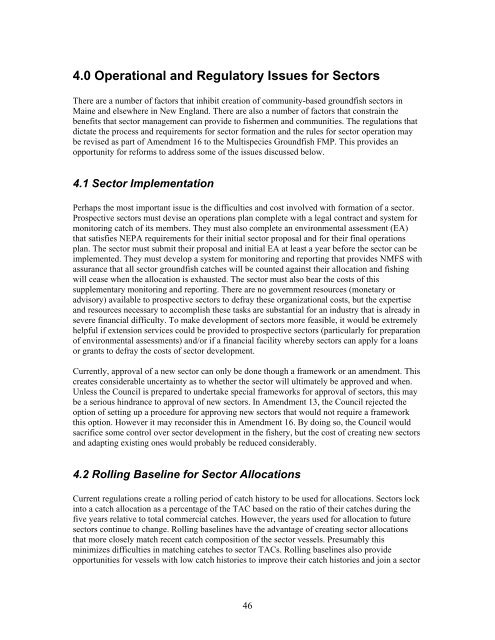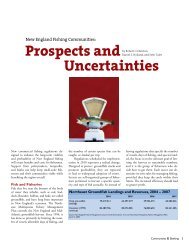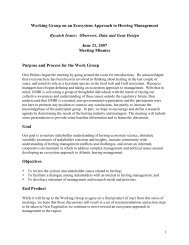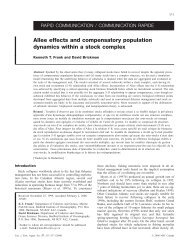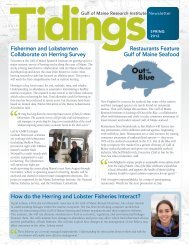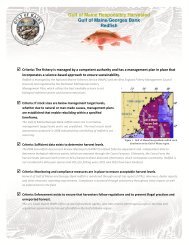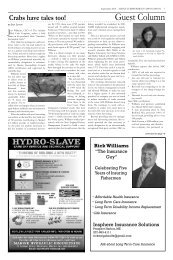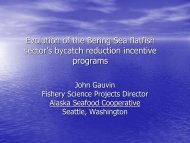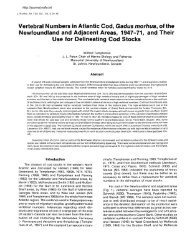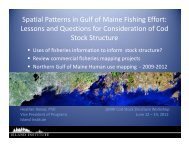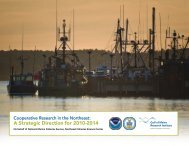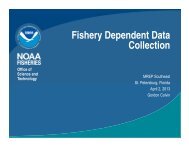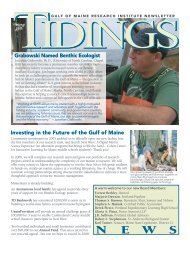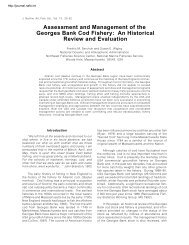Community-based Sectors for the New England Groundfish Fishery
Community-based Sectors for the New England Groundfish Fishery
Community-based Sectors for the New England Groundfish Fishery
You also want an ePaper? Increase the reach of your titles
YUMPU automatically turns print PDFs into web optimized ePapers that Google loves.
4.0 Operational and Regulatory Issues <strong>for</strong> <strong>Sectors</strong><br />
There are a number of factors that inhibit creation of community-<strong>based</strong> groundfish sectors in<br />
Maine and elsewhere in <strong>New</strong> <strong>England</strong>. There are also a number of factors that constrain <strong>the</strong><br />
benefits that sector management can provide to fishermen and communities. The regulations that<br />
dictate <strong>the</strong> process and requirements <strong>for</strong> sector <strong>for</strong>mation and <strong>the</strong> rules <strong>for</strong> sector operation may<br />
be revised as part of Amendment 16 to <strong>the</strong> Multispecies <strong>Groundfish</strong> FMP. This provides an<br />
opportunity <strong>for</strong> re<strong>for</strong>ms to address some of <strong>the</strong> issues discussed below.<br />
4.1 Sector Implementation<br />
Perhaps <strong>the</strong> most important issue is <strong>the</strong> difficulties and cost involved with <strong>for</strong>mation of a sector.<br />
Prospective sectors must devise an operations plan complete with a legal contract and system <strong>for</strong><br />
monitoring catch of its members. They must also complete an environmental assessment (EA)<br />
that satisfies NEPA requirements <strong>for</strong> <strong>the</strong>ir initial sector proposal and <strong>for</strong> <strong>the</strong>ir final operations<br />
plan. The sector must submit <strong>the</strong>ir proposal and initial EA at least a year be<strong>for</strong>e <strong>the</strong> sector can be<br />
implemented. They must develop a system <strong>for</strong> monitoring and reporting that provides NMFS with<br />
assurance that all sector groundfish catches will be counted against <strong>the</strong>ir allocation and fishing<br />
will cease when <strong>the</strong> allocation is exhausted. The sector must also bear <strong>the</strong> costs of this<br />
supplementary monitoring and reporting. There are no government resources (monetary or<br />
advisory) available to prospective sectors to defray <strong>the</strong>se organizational costs, but <strong>the</strong> expertise<br />
and resources necessary to accomplish <strong>the</strong>se tasks are substantial <strong>for</strong> an industry that is already in<br />
severe financial difficulty. To make development of sectors more feasible, it would be extremely<br />
helpful if extension services could be provided to prospective sectors (particularly <strong>for</strong> preparation<br />
of environmental assessments) and/or if a financial facility whereby sectors can apply <strong>for</strong> a loans<br />
or grants to defray <strong>the</strong> costs of sector development.<br />
Currently, approval of a new sector can only be done though a framework or an amendment. This<br />
creates considerable uncertainty as to whe<strong>the</strong>r <strong>the</strong> sector will ultimately be approved and when.<br />
Unless <strong>the</strong> Council is prepared to undertake special frameworks <strong>for</strong> approval of sectors, this may<br />
be a serious hindrance to approval of new sectors. In Amendment 13, <strong>the</strong> Council rejected <strong>the</strong><br />
option of setting up a procedure <strong>for</strong> approving new sectors that would not require a framework<br />
this option. However it may reconsider this in Amendment 16. By doing so, <strong>the</strong> Council would<br />
sacrifice some control over sector development in <strong>the</strong> fishery, but <strong>the</strong> cost of creating new sectors<br />
and adapting existing ones would probably be reduced considerably.<br />
4.2 Rolling Baseline <strong>for</strong> Sector Allocations<br />
Current regulations create a rolling period of catch history to be used <strong>for</strong> allocations. <strong>Sectors</strong> lock<br />
into a catch allocation as a percentage of <strong>the</strong> TAC <strong>based</strong> on <strong>the</strong> ratio of <strong>the</strong>ir catches during <strong>the</strong><br />
five years relative to total commercial catches. However, <strong>the</strong> years used <strong>for</strong> allocation to future<br />
sectors continue to change. Rolling baselines have <strong>the</strong> advantage of creating sector allocations<br />
that more closely match recent catch composition of <strong>the</strong> sector vessels. Presumably this<br />
minimizes difficulties in matching catches to sector TACs. Rolling baselines also provide<br />
opportunities <strong>for</strong> vessels with low catch histories to improve <strong>the</strong>ir catch histories and join a sector<br />
46


